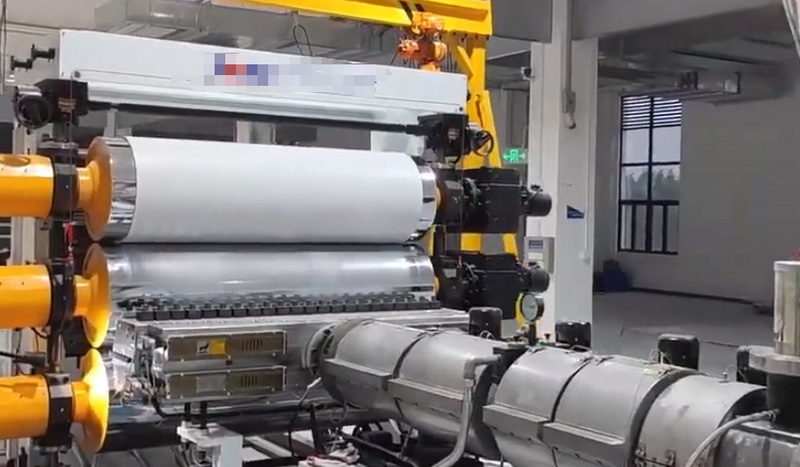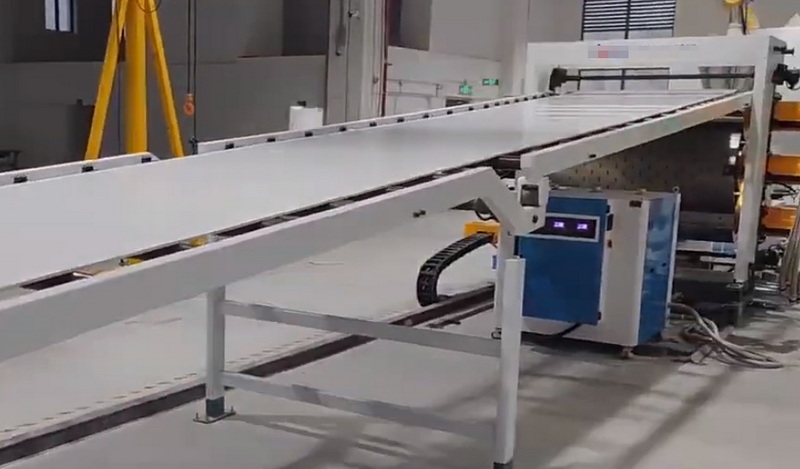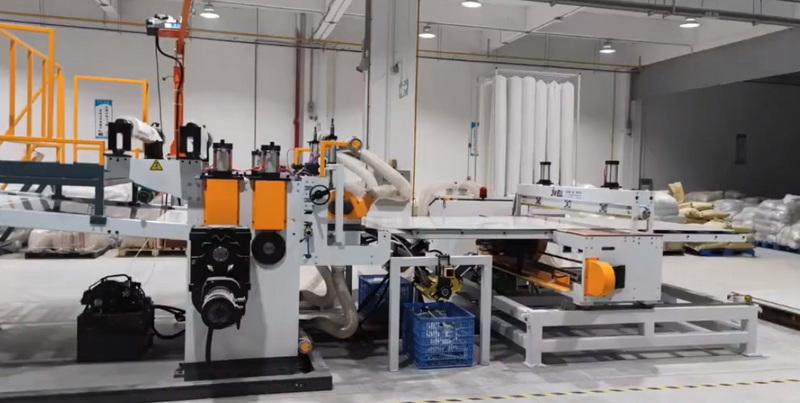Content Menu
● Introduction to Sheet Extrusion Equipment
>> Key Components of Sheet Extrusion Equipment
● How Sheet Extrusion Equipment Works
● Applications of Sheet Extrusion Equipment
● Maintenance of Sheet Extrusion Equipment
● Advances in Sheet Extrusion Technology
● Environmental Considerations
● Conclusion
● Frequently Asked Questions
>> 1. What are the main components of sheet extrusion equipment?
>> 2. How does the extruder in sheet extrusion equipment work?
>> 3. What are the applications of sheet extrusion equipment?
>> 4. Why is maintenance important for sheet extrusion equipment?
>> 5. What factors affect the quality of sheets produced by sheet extrusion equipment?
Sheet extrusion equipment is a crucial component in the manufacturing of plastic sheets, which are widely used in various industries such as packaging, construction, and automotive. This equipment plays a pivotal role in transforming raw plastic materials into uniform, high-quality sheets. In this article, we will delve into the details of sheet extrusion equipment, its components, and the process involved in producing plastic sheets.

Introduction to Sheet Extrusion Equipment
Sheet extrusion equipment, also known as plastic sheet extruders, are designed to convert solid plastic pellets into molten material that is then shaped into sheets of specific thickness and width. The process involves several key components, including the extruder, die, chill rolls, and winding units.
Key Components of Sheet Extrusion Equipment
1. Extruder: This is the heart of the sheet extrusion line. It consists of a heated barrel with a rotating screw that melts and mixes the plastic pellets. The extruder ensures that the material is uniform in temperature and composition before it is pushed through the die. The screw design, including the length-to-diameter ratio and the type of screw elements (e.g., mixing elements), significantly affects the melting efficiency and material quality.
2. Die: The die is responsible for shaping the molten plastic into a sheet. It is designed to ensure that the sheet has the desired width and thickness. The die temperature and gap control are critical for achieving uniformity and accuracy in dimensions. The die design must also account for factors like flow distribution to prevent defects such as necking or edge curl.
3. Chill Rolls: After the sheet leaves the die, it passes over chill rolls, which rapidly cool the sheet to set its dimensions and characteristics. The temperature of the rolls must be carefully controlled to avoid thermal stresses and warping. The roll speed and pressure also influence the final sheet quality.
4. Winding Units: Finally, the cooled sheet is wound into rolls or stacked as flat sheets. This step requires careful handling to prevent superficial defects and ensure material quality. The winding tension and speed must be optimized to prevent creases or wrinkles.
How Sheet Extrusion Equipment Works
The process of sheet extrusion involves several stages:
1. Feeding: Thermoplastic pellets are loaded into a hopper, which supplies the material to the extruder. Factors like particle size and moisture content are crucial for uniform feeding and processing. Proper drying of the material before feeding can prevent issues like bubbles or uneven melting.
2. Melting and Mixing: The pellets are conveyed through a heated barrel using a screw. The material is melted using friction and external heaters, and the screw provides sufficient mixing to achieve a uniform melt. The temperature profile along the barrel is critical to ensure complete melting without overheating.
3. Sheet Extrusion: The molten polymer is pushed through a flat sheet die, which sets the width and thickness of the sheet. The die temperature and gap controls are very important for achieving uniformity and accuracy in dimensions. The die design must also ensure even flow distribution across the sheet width.
4. Cooling and Solidification: The extruded sheet is passed over cooled rollers, which quickly cool the sheet for solidification. The roller temperature must be adequately controlled to avoid thermal stresses and warping. The cooling rate affects the crystallinity and mechanical properties of the final sheet.
5. Trimming and Cutting: The sheet is first trimmed at the edges and then cut to the desired length. Automated systems are usually used for cutting and trimming due to the high precision and low speed requirements. The cutting tools must be sharp to prevent tearing or rough edges.
6. Winding or Stacking: Depending on the application, the final sheets are finished either by rolling them into stacks for shipment or stacking them as flat sheets. Careful treatment at this stage reduces superficial defects and guarantees material quality. The winding tension and speed must be optimized to prevent creases or wrinkles.

Applications of Sheet Extrusion Equipment
Sheet extrusion equipment is widely used in various industries due to its ability to produce high-quality plastic sheets efficiently. Some of the key applications include:
- Packaging: Plastic sheets are used for packaging food, electronics, and pharmaceuticals. They provide a barrier against moisture and contaminants, extending the shelf life of products.
- Construction: Sheets are used for building panels and insulation materials. They offer thermal insulation and can be used in exterior cladding due to their weather resistance.
- Automotive: Sheets are used for trim parts and other components. They are lightweight and can be molded into complex shapes, making them ideal for interior components.
Maintenance of Sheet Extrusion Equipment
Regular maintenance is crucial for the optimal operation and longevity of sheet extruders. Key maintenance tasks include:
- Inspect Drive Components: Check gears, bearings, and belts for wear. Lubricate moving parts regularly to reduce friction and prevent overheating.
- Check Hydraulic System: Inspect pumps, cylinders, and hoses for leaks. Ensure that hydraulic fluid levels are adequate and that the system is free from contamination.
- Examine Electrical System: Ensure motors, cables, and panels function properly. Check for any signs of overheating or electrical faults.
- Clean Equipment: Maintain cleanliness and hygiene. Regular cleaning prevents the buildup of debris and reduces the risk of contamination.
- Inspect Molds: Check molds for wear and replace as necessary. Proper mold maintenance ensures consistent product quality.
- Lubricate Components: Ensure proper lubrication for smooth operation. Regular lubrication reduces wear on moving parts and extends equipment lifespan.
- Control System Checks: Regularly inspect the control system for functionality. Ensure that temperature controls, pressure sensors, and speed controls are accurate and responsive.
- Storage Precautions: Store unused equipment in a dry, ventilated area, with periodic checks. This prevents rust and ensures that the equipment remains in good condition when not in use.
Advances in Sheet Extrusion Technology
Recent advancements in sheet extrusion technology have focused on improving efficiency, reducing energy consumption, and enhancing product quality. Some notable developments include:
- Twin-Screw Extruders: These offer better mixing capabilities and can handle a wider range of materials, including recycled plastics. They provide improved melt quality and consistency.
- Coextrusion: This technique allows for the simultaneous extrusion of multiple layers, enabling the creation of complex structures with different properties. It is used to enhance barrier properties or improve appearance.
- Automated Systems: Modern sheet extrusion lines often incorporate automated systems for monitoring and controlling the process. These systems can adjust parameters in real-time to optimize production efficiency and product quality.
Environmental Considerations
As concern for environmental sustainability grows, the sheet extrusion industry is shifting towards more eco-friendly practices. This includes:
- Use of Recycled Materials: Many manufacturers are incorporating recycled plastics into their sheet production. This reduces waste and conserves natural resources.
- Energy Efficiency: Modern equipment is designed to be more energy-efficient, reducing the carbon footprint of sheet production.
- Biodegradable Materials: There is an increasing interest in using biodegradable plastics, which can reduce environmental impact by decomposing naturally.
Conclusion
Sheet extrusion equipment is a vital tool in the production of plastic sheets, offering a simple, quick, and economical method for creating sheets of specific thickness and high quality. Understanding the components and process involved in sheet extrusion is essential for optimizing production and ensuring the quality of the final product. Regular maintenance is also crucial to extend the lifespan of the equipment and enhance product quality.

Frequently Asked Questions
1. What are the main components of sheet extrusion equipment?
Sheet extrusion equipment primarily consists of an extruder, die, chill rolls, and winding units. The extruder melts and mixes the plastic, the die shapes the sheet, chill rolls cool the sheet, and winding units handle the final product.
2. How does the extruder in sheet extrusion equipment work?
The extruder works by using a rotating screw to convey plastic pellets through a heated barrel, melting and mixing them into a uniform melt. This melt is then pushed through a die to form a sheet.
3. What are the applications of sheet extrusion equipment?
Sheet extrusion equipment is used in packaging, construction, and automotive industries for producing plastic sheets. These sheets are used for packaging food and electronics, building panels, and automotive trim parts.
4. Why is maintenance important for sheet extrusion equipment?
Maintenance is crucial for ensuring the optimal operation and longevity of sheet extruders. It involves inspecting drive components, checking hydraulic and electrical systems, cleaning equipment, and lubricating components to prevent wear and tear.
5. What factors affect the quality of sheets produced by sheet extrusion equipment?
Factors such as temperature control, die design, and roll speed affect the quality of the sheets. Proper control of these factors ensures uniform thickness, minimal warping, and high surface quality.






















